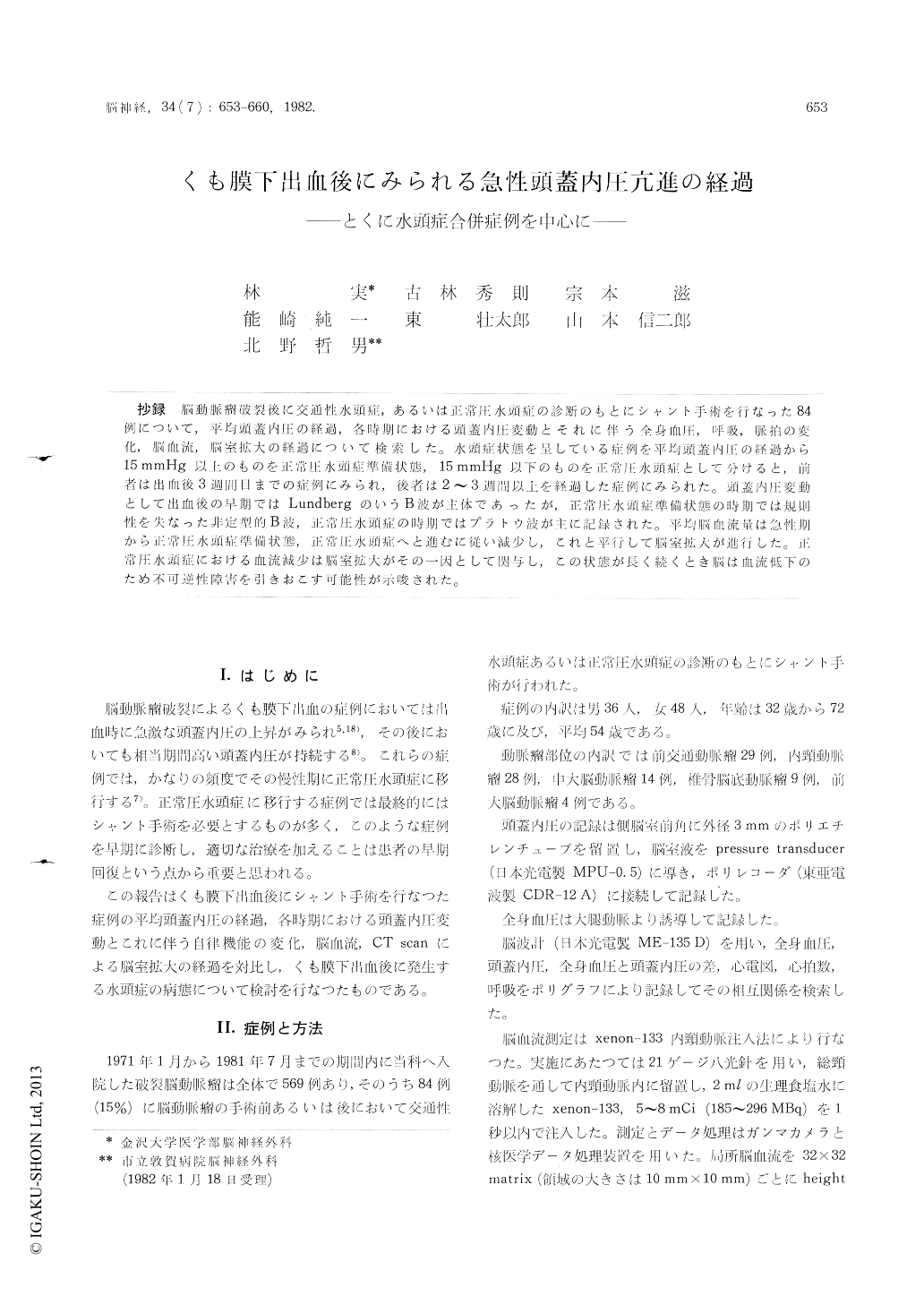Japanese
English
- 有料閲覧
- Abstract 文献概要
- 1ページ目 Look Inside
抄録 脳動脈細破裂後に交通性水頭症,あるいは正常圧水頭症の診断のもとにシャント手術を行なった84例について,平均頭蓋内圧の経過,各時期における頭蓋内圧変動とそれに伴う令身血圧,呼吸,脈拍の変化,脳血流,脳室拡大の経過について検索した。水頭症状態を呈している症例を平均頭蓋内圧の経過から15mmHg以上のものを正常圧水頭症準備状態,15mmHg以下のものを正常圧水頭症として分けると,前者は出血後3週間目までの症例にみられ,後者は2〜3週間以上を経過した症例にみられた。頭蓋内圧変動として出血後の早期ではLundbergのいうB波が主体であったが,正常圧水頭症準備状態の時期では規則性を失なった非定型的B波,正常圧水頭症の上時期ではプラトウ波が主に記録された。平均脳血流量は急性期から正常圧水頭症準備状態,正常圧水頭症へと進むに従い滅少し,これと平行して脳室拡大が進行した。正常圧水頭症における血流減少は脳室拡人がその一因として関与し,この状態が長く続くとき脳は血流低下のため不可逆性障害を引きおこす可能性が示唆された。
This study investigated intracranial pressure, cerebral blood flow, isotope cisternography and CT scan in 84 patients given shunts for communicating hydrocephalus developed after subarachnoid hemor-rhage due to rupture of intracranial aneurysm at the Department of Neurosurgery, Kanazawa Uni-versity from January, 1971 to July, 1981. (A total of 569 ruptured intracranial aneurysm patients were admitted during the period. Therefore, the fre-quency of communicating hydrocephalus after subarachnoid hemorrhage was 15% in our study.)
The hydrocephalic patients were divided into 2 groups: the pre-normal pressure hydrocephalus group with a mean intracranial pressure of more than 15 mmHg and normal pressure hydrocephalus group with a mean intracranial pressure of less than 15 mmHg.
In the 26 patients who later developed com-municating hydrocephalus, the intracranial pressure was studied in the acute stage. Of these, 88% were found to show high intracranial pressure in the range of 20 to 45 mmHg and were classifiedas Grade III and IV by Hunt and Hess.
Of the 84 patients, 37% showed angiographic evidence of diffuse cerebral vasospasm at some time in their course. The high incidence of in-creased intracranial pressure in the acute stage and/or diffuse cerebral vasospasm in patients who later developed communicating hydrocephalus suggest that clots in the subarachnoid space are most responsible for causing this condition.
The intracranial pressure in the acute stage patients showed a marked tendency to rapid varia-tions superimposed on an increased intracranial pressure. Analysis revealed only 2 variations, that is, Lundberg's B-waves related to periodic breathing of Cheyne-Stokes Type and Lundberg's C-waves related to systemic blood pressure change. On the other hand, the recordings of the pre-normal pres-sure hydrocephalus patients showed plateau and/or B-waves of Lundberg superimposed on an elevated base pressure. There are 2 kinds of pressure pat-terns in the normal pressure hydrocephalus patients. In one the intracranial pressure curve showed plateau and/or B-waves superimposed on a low intracranial pressure, and in the other the intra-cranial pressure recordings showed no irregularities even if the recordings were continued overnight. The first pattern was seen in patients whose record-ings were made within 63 days after the hemor-rhage, whereas the second pattern was observed in patients whose recordings were begun more than 5 months after the hemorrhage.
The correlation between clinical status and the ventricular size was studied. (The degree of hydro-cephalus was determined by the method based on Taveras and Morello (1979). The normal range is between 36 and 48, with a mean about 42.) The ventricular score number ranged between 28 and 58, with a mean of 48 in the acute stage, between 55 and 87, with a mean of 63 in pre-normal pressure hydrocephalus patients, between 62 and 84, with a mean of 74 in normal pressure hydrocephalus with pressure variations and between 78 and 84 in normal pressure hydrocephalus with no pressure irregularities. Thus, the increased ventricular size was accompanied by decreased in-tracranial pressure in patients with developing normal pressure hydrocephalus.
The correlation between clinical status and cere-bral blood flow was also studied. The mean value of 42.4±7.19ml/100g/min was obtained in the acute stage. Flows of 33.8±3.69, 29.2±2.20, 23.3 ±0.82 ml/100g/min were found in pre-normal pressure hydrocephalus, normal pressure hydro-cephalus with pressure variations and normal pres-sure hydrocephalus with no pressure irregularities, respectively.
We suggest that reduction in cerebral blood flow in normal pressure hydrocephalus patients may play an important role in producing dilatation of the ventricular system and that reduced cerebral blood flow in a long-lasting normal pressure hydro-cephalus state may produce irreversible damage in brain tissue.

Copyright © 1982, Igaku-Shoin Ltd. All rights reserved.


